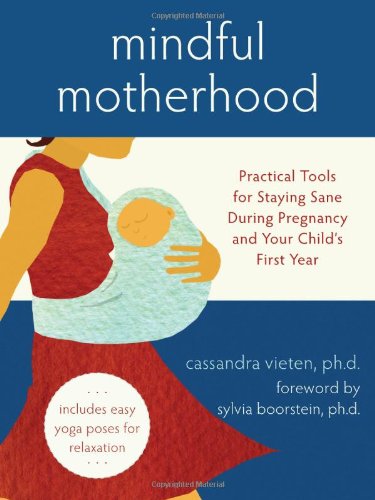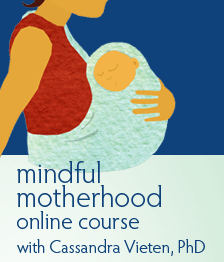Practical Tools for Staying Sane: Incorporating Mindfulness Into Motherhood
Listen to a Mindful Motherhood teleconference with Cassandra Vieten, PhD below. You can find the online course Mindful Motherhood, at the Institute of Noetic Sciences, here.
Mindful Motherhood, simply put, is being present in your body, and connected with your baby even when the going gets rough. It’s being aware of your experience from moment to moment, as it is happening, without pushing it away, trying to make it stay, or judging it as bad or good. It is meeting each situation as it is, and over time, more and more often, approaching whatever is happening with curiosity and compassion.
Mindful Motherhood is a way of approaching all of the experiences you’ll encounter as a mom with open eyes and an open heart. Whether those experiences are internal, like thoughts, feelings, or body sensations; or external, like relationships, workplace situations, or the situations in your environment, mindful motherhood is a way of simply being with whatever is happening, no matter what it is. While it may be simple, for most of us, it’s not easy.
 You are always actually in the moment and in your body–there is no other place to be, when you really get down to it. But often, your attention is not directed toward the present moment. In the same way, you are always connected with your baby, whether you feel like you are or not. Bringing mindful awareness to that connection can enhance it for both you and your baby. There are a few key elements of healthy connection with your baby that happen naturally, without you needing to try at all. Becoming more consciously aware of how you are connecting is not so much about trying to be a good mom or setting a high standard for yourself to try to achieve. Similar to mindful awareness, you can’t make yourself connect with your baby. The connection is already there and does not need to be created. Mindful motherhood is more about being awake and aware as the connection is happening and creating the optimal conditions for the natural connection between you and your baby to emerge. For the most part, you don’t need to do anything except get out of your own way and allow what is happening to be just as it is. Mindful awareness can help you with that.
You are always actually in the moment and in your body–there is no other place to be, when you really get down to it. But often, your attention is not directed toward the present moment. In the same way, you are always connected with your baby, whether you feel like you are or not. Bringing mindful awareness to that connection can enhance it for both you and your baby. There are a few key elements of healthy connection with your baby that happen naturally, without you needing to try at all. Becoming more consciously aware of how you are connecting is not so much about trying to be a good mom or setting a high standard for yourself to try to achieve. Similar to mindful awareness, you can’t make yourself connect with your baby. The connection is already there and does not need to be created. Mindful motherhood is more about being awake and aware as the connection is happening and creating the optimal conditions for the natural connection between you and your baby to emerge. For the most part, you don’t need to do anything except get out of your own way and allow what is happening to be just as it is. Mindful awareness can help you with that.
As a mom, having your attention in the present moment lays the groundwork for what developmental psychologist Daniel Stern called being attuned to your baby, or being aware of and perceiving accurately your baby’s communication of her emotions and needs (1985). Attunement with your baby is sort of like a tuning fork–the baby hits a particular tone, and you resonate with that tone, reflecting it back to her with your facial expressions, tone of voice, touch, and way of being. These subtle actions communicate “Yes, I see and hear you, and I get what you’re feeling.” Through thousands of these little micro-interactions with your baby, her sense of self develops, as well as her own capacity to begin to learn how to deal with her emotions.
For example, let’s say you’re talking on the phone while the baby is playing on your lap, and the baby starts to squirm. You keep talking but begin to notice what the baby’s doing. Your baby screws up her face and arches her back. Here, you could try to continue your conversation, maybe bounce the baby up and down on your knee, or toss her over your shoulder and begin to pat her back. You might tense your body up a little because you were really hoping to talk to your mom, who you hadn’t talked to in several days, and you start to talk a little louder.
Alternatively, you could stop when you notice the screwed-up face and arched back, either by asking Mom to hold on for a few minutes or asking to call her back, and take a look into your baby’s face and body. Naturally, you might screw your face up a little too, making a soothing sound that is the flip side of what the baby is making.
Neither of these choices is necessarily right or wrong. (I’m being serious here. It would not be mindful mothering to drop everything whenever the baby squirms). But bringing mindful awareness to this moment (being present in the moment, in your body, connected with baby, letting the experience be exactly as it is without needing to change it, and approaching it with curiosity and compassion) will help you notice what’s going on in your baby’s experience and make a choice about how to respond.
Attunement is not just matching your baby’s state. It’s making a complementary response, one that both conveys your empathy (“I can feel what you are feeling”) and responds appropriately to what the baby is communicating. For example, if the baby gets really upset, it’s not ideal attunement to get equally upset. Ideal attunement might be making sure the baby knows that you see that he’s upset and reflecting a sense of being able to tolerate or contain that upset. This reaction could be holding him with firmness and making low and deep sounds. Luckily, with present-moment mindful awareness that meets experiences as they are, this comes pretty naturally–you don’t have to figure it out with your thinking mind.
Use your present-moment awareness to explore what the baby may be trying to tell you. “Get me off my back. I want to be on my tummy!”, “I want to sit up!”, “I’m tired but can’t get to sleep!”, or “My diaper is wet!” You won’t always be able to tell exactly what’s going on, and if you guess, it will still be a story you are telling yourself about the situation. But the main thing is that you’re communicating with your baby and letting her know, “I get it. I see you are uncomfortable. Let’s work as a team. What can we do?”
Transmitting a secure sense of self through attunement happens in thousands of micro-interactions, not just one, or two, or even fifty. This is not about being perfectly attuned all the time–that’s impossible. It’s about deciding that you want to actively engage, more and more often, in present-moment awareness with your baby and cultivating the capacity to do so. Your baby is always in the present moment. Mindful awareness allows you to join her there more often.
Mindful Motherhood is based on research conducted at California Pacific Medical Center’s Research Institute and the Institute of Noetic Sciences.

Mindful Motherhood Book and Online Course
 How can you learn more about mindful mothering? There may be a Mindful Motherhood or other mindful parenting course in your area, and you can also look for a Mindfulness-Based Stress Reduction course which won’t be focused directly on motherhood, but will teach you mindfulness practices that can be applied to all areas of your life.
How can you learn more about mindful mothering? There may be a Mindful Motherhood or other mindful parenting course in your area, and you can also look for a Mindfulness-Based Stress Reduction course which won’t be focused directly on motherhood, but will teach you mindfulness practices that can be applied to all areas of your life.
If you’d like to take a course online – try the Mindful Motherhood Online Course – a companion to the book Mindful Motherhood: Practical Tools for Staying Sane During Pregnancy and Your Child’s First Year (New Harbinger/Noetic Books, 2009).
Based on a program developed in a clinical trial with pregnant women, this program teaches pregnant women and new moms how mindfulness and acceptance-based practices can be brought into their everyday lives to reduce stress, improve mood and enhance bonding with their babies. This online course offers many different ways to explore the information including video lectures, downloadable audio-guided mindfulness practices, pdf readings and exercises, and links to numerous multimedia resources for further exploration. Also for those in the health care professionals who wish to incorporate the Mindful Motherhood Training into their work, IONS offers an online course for professionals with 15 hours of continuing education.


